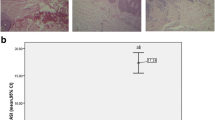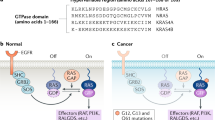Summary
The ras oncogene product, ras p21, is structurally homologous to guanine nucleotide-binding proteins, which play an important role in transmembrane signaling systems. Recently, enhanced expression of ras p21 has been reported in the psoriatic hyperproliferative epidermis, in which various alterations in the transmembrane signaling systems are well established. Since ras-proto-oncogenes are known to be activated by a single point mutation that is restricted to the amino acid residues either at position 12, 61 or in their vicinity, we investigated whether the increased expression of ras p21 in psoriatic epidermis is accompanied by mutation of the ras gene at these sites. The results obtained using samples from five cases of psoriasis revealed no evidence for such mutation. Although the psoriatic epidermis may exhibit enhanced expression of ras p21, this is apparently not accompanied by ras mutation.
Similar content being viewed by others
References
Adachi K, Yoshikawa K, Halprin KM, Levine V (1975) Prostaglandins and cyclic AMP in epidermis. Br J Dermatol 92:381–388
Balmain A, Ramsden M, Bowden GT, Smith J (1984) Activation of the mouse cellular Harvey-ras gene in chemically induced benign skin papillomas. Nature 307:658–660
Barbacid M (1987) ras Genes. Annu Rev Biochem 56:779–827
Bartel RL, Marcelo CL, Voorhees JJ (1987) Partial characterization of phospholipase C activity in normal, psoriatic uninvolved, and lesional epidermis. J Invest Dermatol 88:447–451
Bourne HR (1986) One molecular machine can transduce diverse signals. Nature 321:814–816
Chesa PG, Rettig WJ, Melamed MR, Old LJ, Niman HL (1987) Expression of p21ras in normal and malignant human tissues: Lack of association with proliferation and malignancy. Proc Natl Acad Sci USA 84:3234–3238
Elder JT, Zeigler ME, Wicha MS, Voorhees JJ (1988) Increased c-myc and c-ras mRNA levels in psoriatic epidermis. J Invest Dermatol 90:555
Gibbs JB, Sigal IS, Poe M, Scolnick EM (1984) Intrinsic GTPase activity distinguishes normal and oncogenic ras p21 molecule. Proc Natl Acad Sci USA 81:5704–5708
Gibbs JB, Sigal IS, Scolnick EM (1985) Biochemical properties of normal and oncogenic ras p21. Trends Biochem Sci 10:350–353
Gilman AG (1987) G Proteins: transducers of receptor-generated signals. Annu Rev Biochem 56:615–649
Hagag N, Halegoua S, Viola M (1986) Inhibition of growth factor-induced differentiation of PC 12 cells by microinjection of antibody to ras p21. Nature 319:680–682
Harper JR, Roop DR, Yuspa SH (1986) Transfection of the EJ ras HA gene into keratinocytes derived from carcinogen-induced mouse papillomas causes malignant progression. Mol Cell Biol 6:3144–3149
Horn F, Marks F, Fisher GJ, Marcelo CL, Voorhees JJ (1987) Decreased protein kinase C activity in psoriatic versus normal epidermis. J Invest Dermatol 88:220–222
Iizuka H, Adachi K, Halprin KM, Levine V (1978) Cyclic AMP accumulation in psoriatic skin: Differential response to histamine, AMP, and epinephrine by the uninvolved and involved epidermis. J Invest Dermatol 70:250–253
Iizuka H, Hirokawa M, Ara M, Kajita S, Watanabe M, Ohkawara A (1986) Antipsoriatic and antimetabolic agents as stimulators of the beta-adrenergic adenylate cyclase response of epidermis. Clin Exp Dermatol 11:238–245
Iizuka H, Matsuo S, Tamura T, Ohkuma N (1988) Increased cholera toxin-, and forskolin-induced cyclic AMP accumulations in psoriatic involved versus uninvolved or normal human epidermis. J Invest Dermatol 91:154–157
Kobayashi H, Yasuda H, Ohkawara A, Dosaka H, Oda A, Ogiso Y, Kuzumaki N (1988) Enhanced expression of ras gene products in psoriatic epidermis. Arch Dermatol Res 280:259–263
Manne V, Bekesi E, Kung H-F (1985) Ha-ras proteins exhibit GTPase activity: Point mutations that activate Ha-ras gene products result in decreased GTPase activity. Proc Natl Acad Sci USA 82:376–380
Mordovtsev VN, Starkov IV, Zabarovsky ER, Kisselev LL (1988) Expression of the protooncogenes in psoriatic lesions. Arch Dermatol Res 280:8–11
Mulcahy LS, Smith MR, Stacey DW (1985) Requirement for ras proto-oncogene function during serum-stimulated growth of NIH 3T3 cells. Nature 313:241–243
Nanney LB, Stoscheck CM, Magid M, King LE Jr. (1986) Altered [125I]epidermal growth factor binding and receptor distribution in psoriasis. J Invest Dermatol 86:260–265
Nishimura S, Sekiya T (1987) Human cancer and cellular oncogenes. Biochem J 243:313–327
Pelling JC, Neades R, Strawhecker J (1988) Epidermal papillomas and carcinomas induced in uninitiated mouse skin by tumor promoters alone contain a point mutation in the 61st codon of the Ha-ras oncogene. Carcinogenesis 9:665–667
Saiki RK, Gelfand DH, Stoffel S, Scharf SJ, Higuchi R, Horn GT, Mullis KB, Erlich HA (1988) Primer-directed enzymatic amplification of DNA with a thermostable DNA polymerase. Science 239:487–491
Sanger F, Nicklen S, Coulson AR (1977) DNA sequencing with chain termination method. Proc Natl Acad Sci USA 74:5463–5467
Slamon DJ, Cline MJ (1984) Expression of cellular oncogenes during embryonic and fetal development of the mouse. Proc Natl Acad Sci USA 81:7141–7145
Strickland JE, Greenhalgh DA, Koceva-Chyla A, Hennings H, Restrepo C, Balaschak M, Yuspa SH (1988) Development of murine epidermal cell lines which contain an activated rasHa oncogene and form papillomas in skin grafts on athyimic nude mouse hosts. Cancer Res 48:165–169
Tarpley WG, Hopkins NK, Gorman RR (1986) Reduced hormone-stimulated adenylate cyclase activity in NIH-3T3 cells expressing the EJ human bladder ras oncogene. Proc Natl Acad Sci USA 83:3703–3707
Ui M (1984) Islet-activating protein, pertussis toxin: A probe of the inhibitory guanine nucleotide regulatory component of adenylate cyclase. Trends Pharmacol Sci 5:277–279
Wakelam MJO, Davis SA, Houslay MD, McKay I, Marshall CJ, Hall A (1986) Normal p21N-ras couples bombesin and other growth factor receptors to inositol phosphate production. Nature 323:173–176
Yamanishi K, Kishimoto S, Yasuno H (1989) DNA synthesis in cultured rat epidermal cells expressing exogenous human Harvey ras proto-oncogene. J Invest Dermatol 92:545




